 |
Please click here for a March 2003 update on this series

So - you depleted your CD funds to pay all those energy bills and income taxes. Must a long, hard winter spawn a silent spring? Fortunately, no. Naxos has just released superb restorations of some of the greatest recordings of all time at a super-budget price.
Naxos has a proud history of shaking up classical retailing. Founded in 1987 by Hong Kong-based concert promoter and record importer Klaus Heymann, Naxos set out to sell CDs by worthy but unknown artists for one-third the going rate of standard labels. In truth, Naxos renditions of the standard repertoire tend to be bland and their A&R matches can be quirky (ie: American music by the National Symphony Orchestra of the Ukraine). The glory of the Naxos catalog is stuff you can't find elsewhere - like the complete band output of John Philip Sousa (16 CDs) or all of Grieg's piano music (14 CDs) - at prices that encourage exploration and even impulse buys. In barely a decade, dedicated international distribution and the inherent appeal to both novice and experienced collectors of its deep catalog and tiny prices have made Naxos the largest-selling classical label in the world. More significantly, Naxos has restored much of the joy of record collecting.
The latest Naxos foray is into historical reissues. Here, too, they've done things differently - and right. While all their material has appeared before, it's never sounded so good. All too often, CD transfers meant playing battered 78s through intrusive circuitry to remove all scratches, radical filtering to eliminate all hiss and aggressive equalization to “improve” the tonal balance. Such extreme processing also purged most of the overtones and musical quality, fostering false perceptions that the original sources sounded awful and that acclaimed venerable artists were crude technicians. Naxos has hired the superstars of the transfer field who apply subtle, sophisticated restoration techniques with a sensitive artistic ear to produce glorious results. The sonic excellence and musical integrity of the Naxos transfers supercedes all prior issues, even those on pricey specialty or original labels. Every volume is a thrilling rediscovery that renews appreciation for the genius of the performers' artistry. Generous samples (often entire albums) are offered for streaming on the Naxos website. And such a bargain!
Here are the sets that I cherish the most so far:
- Enrico Caruso - Complete Recordings (1902-20) - Ninety-nine years ago a promising young tenor named Enrico Caruso reported to a Milan hotel room
 and within two hours cut his first ten sides. Although no one could have envisioned it at the time, his primitive recording session turned out to be one of the most crucial events in the annals of Western culture. Today, eighty years after his untimely death, Caruso remains not only the first but in many ways the most important star the record industry has ever known, as he defined the dynamics that still govern music. His hugely successful records of songs and arias transformed the phonograph from a technological curiosity into a potent social force by bringing culture to the masses, who repaid the favor by bestowing upon Caruso unprecedented worldwide fame. While the limited tonal response and dynamic range of the early acoustical system disfigured most instruments and ensembles, it captured and reproduced Caruso's awesome, ringing voice and bold personality magnificently. His records still sound marvelous, and never as well as in the present transfers. Three volumes of a projected twelve are already available. and within two hours cut his first ten sides. Although no one could have envisioned it at the time, his primitive recording session turned out to be one of the most crucial events in the annals of Western culture. Today, eighty years after his untimely death, Caruso remains not only the first but in many ways the most important star the record industry has ever known, as he defined the dynamics that still govern music. His hugely successful records of songs and arias transformed the phonograph from a technological curiosity into a potent social force by bringing culture to the masses, who repaid the favor by bestowing upon Caruso unprecedented worldwide fame. While the limited tonal response and dynamic range of the early acoustical system disfigured most instruments and ensembles, it captured and reproduced Caruso's awesome, ringing voice and bold personality magnificently. His records still sound marvelous, and never as well as in the present transfers. Three volumes of a projected twelve are already available.
- Bach: Six Suites for Solo Cello (Pablo Casals, 1936-9) - It's hard to believe, but a century ago the cello was largely
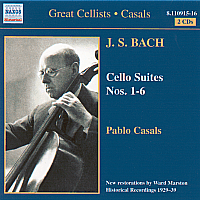 disdained as too inexpressive and clumsy for solo work, and the music of Bach was virtually unknown, its polyphonic style dismissed as primitive and of only passing academic interest. Casals would soon change all that. In 1890 the 13-year old was playing in Barcelona cafes when he discovered the scores of Bach's cello suites. Astounded by their richness, he studied them intensively for twelve years before introducing them to the public. His ardor for these deceptively simple pieces never dimmed - he began every day of his incredibly long life by playing two of them. He also made the Suites the centerpiece of an innovative bold and expressive playing style that transformed perception of his instrument. Finally, in his early 60s, he recorded them. There have been dozens of complete recordings since then; most recently Yo Yo Ma's became a cultural event, accompanied by concert tours, videos and TV specials. But it all began with Casals, whose version remains unique for his power, impulse and soulful conviction. disdained as too inexpressive and clumsy for solo work, and the music of Bach was virtually unknown, its polyphonic style dismissed as primitive and of only passing academic interest. Casals would soon change all that. In 1890 the 13-year old was playing in Barcelona cafes when he discovered the scores of Bach's cello suites. Astounded by their richness, he studied them intensively for twelve years before introducing them to the public. His ardor for these deceptively simple pieces never dimmed - he began every day of his incredibly long life by playing two of them. He also made the Suites the centerpiece of an innovative bold and expressive playing style that transformed perception of his instrument. Finally, in his early 60s, he recorded them. There have been dozens of complete recordings since then; most recently Yo Yo Ma's became a cultural event, accompanied by concert tours, videos and TV specials. But it all began with Casals, whose version remains unique for his power, impulse and soulful conviction.
- Mozart: The Magic Flute (Sir Thomas Beecham conducting, soloists, Berlin Philharmonic Orchestra, 1937-8) - If,
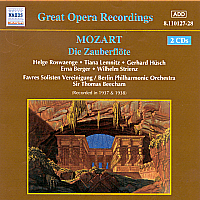 as the great conductor Bruno Walter wrote, Mozart's last and perhaps greatest opera is a spiritual testament, a musical expression of his complex personality, it's also a baffling jumble of fairy-tale plot, exotic locale, rustic humor, political overtones and Masonic symbolism, all reflected in a score of wide-ranging style. The challenge of a great rendition is to unify these disparate elements. Toscanini pressed them into a sharp, human drama while Furtwangler crafted a metaphysical epic, but in this first complete studio recording Beecham eschews a distinctive psychic or cosmic vision and instead coalesces the sprawling work into a tapestry of moderation, balance and deeply humanistic warmth. The result is effortless and universal, letting each listener draw from it whatever we may choose. The dialogue is all cut, leaving a distillation of Mozart's sublime music. One sour note - as the liner notes rather gingerly hint, despite the excellence of the artists, “it is sometimes suggested that political considerations were a factor in the selection of the cast and that some more experienced singers might otherwise have been chosen to take part.” Translation: this was Berlin in 1936, only certified Aryans could step before Nazi microphones and Sir Thomas, never known for political courage, willingly acquiesced. as the great conductor Bruno Walter wrote, Mozart's last and perhaps greatest opera is a spiritual testament, a musical expression of his complex personality, it's also a baffling jumble of fairy-tale plot, exotic locale, rustic humor, political overtones and Masonic symbolism, all reflected in a score of wide-ranging style. The challenge of a great rendition is to unify these disparate elements. Toscanini pressed them into a sharp, human drama while Furtwangler crafted a metaphysical epic, but in this first complete studio recording Beecham eschews a distinctive psychic or cosmic vision and instead coalesces the sprawling work into a tapestry of moderation, balance and deeply humanistic warmth. The result is effortless and universal, letting each listener draw from it whatever we may choose. The dialogue is all cut, leaving a distillation of Mozart's sublime music. One sour note - as the liner notes rather gingerly hint, despite the excellence of the artists, “it is sometimes suggested that political considerations were a factor in the selection of the cast and that some more experienced singers might otherwise have been chosen to take part.” Translation: this was Berlin in 1936, only certified Aryans could step before Nazi microphones and Sir Thomas, never known for political courage, willingly acquiesced.
- Sergei Rachmaninoff: The Four Piano Concertos; Rhapsody on a Theme of Paganini (Rachmaninoff, piano, with the Philadelphia
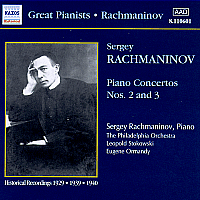 Orchestra conducted by Leopold Stokowski and Eugene Ormandy, 1929-41) - Rachmaninoff presents a striking duality. His composing style was sprawling and deeply Romantic, but his huge success as a pianist stemmed from clear, controlled playing that outlined the architecture of each piece. The two facets fuse in his own recordings of his concerti and the Rhapsody, which are direct and full of conviction, towering over dozens of other superheated or cloying renditions. They're also mesmerizing; after all, there's nothing so erotic as diffident beauty. The Naxos edition is fascinating for the light it sheds on the art of transfers, as it contrasts the work of the two giants in the field. Ward Marston engineered the award-winning 1992 BMG Rachmaninoff Edition with a dry, crisp sound that reflects published descriptions of Rachmaninoff's ascetic style. Mark Obert-Thorn provides Naxos with a much warmer acoustic that evokes the composer's passion, as well as the rich sonic blend of the Philadelphia Orchestra. Neither is “correct;” both enrich our understanding of a complex artist. Orchestra conducted by Leopold Stokowski and Eugene Ormandy, 1929-41) - Rachmaninoff presents a striking duality. His composing style was sprawling and deeply Romantic, but his huge success as a pianist stemmed from clear, controlled playing that outlined the architecture of each piece. The two facets fuse in his own recordings of his concerti and the Rhapsody, which are direct and full of conviction, towering over dozens of other superheated or cloying renditions. They're also mesmerizing; after all, there's nothing so erotic as diffident beauty. The Naxos edition is fascinating for the light it sheds on the art of transfers, as it contrasts the work of the two giants in the field. Ward Marston engineered the award-winning 1992 BMG Rachmaninoff Edition with a dry, crisp sound that reflects published descriptions of Rachmaninoff's ascetic style. Mark Obert-Thorn provides Naxos with a much warmer acoustic that evokes the composer's passion, as well as the rich sonic blend of the Philadelphia Orchestra. Neither is “correct;” both enrich our understanding of a complex artist.
- Gershwin Plays Gershwin (1924-31) - Just as a fine transfer can immeasurably enhance an old performance, this volume is an
 unfortunate reminder of the damage a careless effort can wield. The inimitable 1924 creators' record of the Rhapsody in Blue with the Paul Whiteman Orchestra sounds fine, and the rarely-heard (and decidedly lesser) 1931 Second Rhapsody sequel seems as good as can be expected from its transcription source, but ten song transcriptions and the Three Preludes are thick, coarse and distorted, making the composer sound plodding and clumsy when compared with a 1976 Victrola LP transfer (AVM1-1740), which had displayed the grace and finesse for which Gershwin's famed pianism was acclaimed. (One further gripe - this CD had enough room to have included the marvelous 1929 Shilkret-led premiere of An American in Paris featuring Gershwin at the celesta and his original Parisian taxi horns.) unfortunate reminder of the damage a careless effort can wield. The inimitable 1924 creators' record of the Rhapsody in Blue with the Paul Whiteman Orchestra sounds fine, and the rarely-heard (and decidedly lesser) 1931 Second Rhapsody sequel seems as good as can be expected from its transcription source, but ten song transcriptions and the Three Preludes are thick, coarse and distorted, making the composer sound plodding and clumsy when compared with a 1976 Victrola LP transfer (AVM1-1740), which had displayed the grace and finesse for which Gershwin's famed pianism was acclaimed. (One further gripe - this CD had enough room to have included the marvelous 1929 Shilkret-led premiere of An American in Paris featuring Gershwin at the celesta and his original Parisian taxi horns.)
- Jascha Heifetz - violin concertos by Beethoven, Brahms, Tchaikovsky, Sibelius, Prokofiev, Gruenberg, Viextemps, Elgar and others (1934 - 1949) -
 Heifetz boasted the most spectacular technique of any violinist on record. Yet, our memories are molded by his crisp, precise and efficient stereo remakes of favorite concerti. These earlier versions are just as propulsive and exciting, but with just enough repose and expression to impart deep human feelings. They also convey the rich sound of the gut strings which Heifetz used to offset his dazzling brilliance. Previous CD transfers were shrill and harsh, but these restore the warmth of the originals. The result is not just a vastly more enjoyable listening experience, but far more important - it compels reevaluation of Heifetz's extraordinary artistry. Heifetz boasted the most spectacular technique of any violinist on record. Yet, our memories are molded by his crisp, precise and efficient stereo remakes of favorite concerti. These earlier versions are just as propulsive and exciting, but with just enough repose and expression to impart deep human feelings. They also convey the rich sound of the gut strings which Heifetz used to offset his dazzling brilliance. Previous CD transfers were shrill and harsh, but these restore the warmth of the originals. The result is not just a vastly more enjoyable listening experience, but far more important - it compels reevaluation of Heifetz's extraordinary artistry.
- Delius: Various Works (Royal and London Philharmonic Orchestras, Sir Thomas Beecham conducting, 1927-38) -
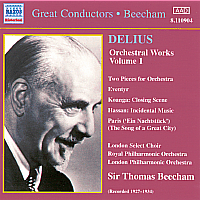 While the English tend to regard Delius as a composer of genius, the rest of the world considers him more of an acquired taste. His reputation, such as it is, was largely due to the untiring advocacy of Beecham, whose first series of recordings was begun while the reclusive composer was still alive, albeit ailing, and brought him great joy. While the more detailed sound and languid conducting of Beecham's later remakes better portrayed the wispy nature pieces about flowery gardens and cuckoos in spring, these earlier forays throb with a pioneering commitment; their thrilling sparkle and energy bring us closer to the ardent character and intense color of the more substantial works (Eventyr, Sea Drift, Paris) and fully justify Beecham's devotion and proselytizing. While the English tend to regard Delius as a composer of genius, the rest of the world considers him more of an acquired taste. His reputation, such as it is, was largely due to the untiring advocacy of Beecham, whose first series of recordings was begun while the reclusive composer was still alive, albeit ailing, and brought him great joy. While the more detailed sound and languid conducting of Beecham's later remakes better portrayed the wispy nature pieces about flowery gardens and cuckoos in spring, these earlier forays throb with a pioneering commitment; their thrilling sparkle and energy bring us closer to the ardent character and intense color of the more substantial works (Eventyr, Sea Drift, Paris) and fully justify Beecham's devotion and proselytizing.
- Fritz Kreisler - Beethoven, Mendelssohn and Brahms Violin Concertos (Berlin State Opera Orchestra, Leo Blech conducting, 1926-7).
 Kreisler remade these concerti in the mid-30s with Barbirolli in decent but less distinctive renditions, whose wider distribution have tended to eclipse these superior early electricals. Not only was Kreisler's deteriorating technique considerably more secure in his first series, but the sensitivity of conductor Leo Blech, the texture of a reduced ensemble and an incredibly warm acoustic combine to nestle Kreisler's wonderfully sweet tone in an inviting chamber-like setting of gentle intimacy that has never been matched. The Beethoven, in particular, is a performance of unparalleled beauty and grace. Kreisler remade these concerti in the mid-30s with Barbirolli in decent but less distinctive renditions, whose wider distribution have tended to eclipse these superior early electricals. Not only was Kreisler's deteriorating technique considerably more secure in his first series, but the sensitivity of conductor Leo Blech, the texture of a reduced ensemble and an incredibly warm acoustic combine to nestle Kreisler's wonderfully sweet tone in an inviting chamber-like setting of gentle intimacy that has never been matched. The Beethoven, in particular, is a performance of unparalleled beauty and grace.
- Beethoven: Symphonies (Hans Pfitzner, Richard Strauss, Erich Kleiber and Oskar Fried conducting, 1926-32) - Although Beethoven symphony cycles have since
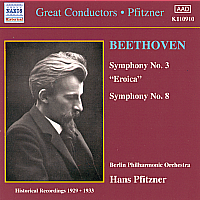 become commonplace (Karajan did it four times!), this early one was quite a daring undertaking in its time. Unlike most subsequent sets that reflect the unified artistic vision of a single interpreter, this one was spread among four conductors, and presents a variety of artistic results. Symphonies 1, 3, 4, 6 and 8 were led by Hans Pfitzner and, while only marginally inspired, serve to document the solid German mainstream conducting tradition of the time. Strauss's driven and impulsive Fifth and Seventh belie his reputation as a bored, uninvolved time-beater. Fried's Ninth confounds expectations as well with unremitting momentum and minimal inflection, hardly what we would expect of a Mahler acolyte. become commonplace (Karajan did it four times!), this early one was quite a daring undertaking in its time. Unlike most subsequent sets that reflect the unified artistic vision of a single interpreter, this one was spread among four conductors, and presents a variety of artistic results. Symphonies 1, 3, 4, 6 and 8 were led by Hans Pfitzner and, while only marginally inspired, serve to document the solid German mainstream conducting tradition of the time. Strauss's driven and impulsive Fifth and Seventh belie his reputation as a bored, uninvolved time-beater. Fried's Ninth confounds expectations as well with unremitting momentum and minimal inflection, hardly what we would expect of a Mahler acolyte.
- Arturo Toscanini - NBC broadcasts (1938-46) - Most of us glean our knowledge of Toscanini from the dry classicism of his late records
 that BMG keeps recycling. Yet, the Toscanini of legend who regularly astounded his colleagues and revolutionized classical performance is far more evident from his weekly broadcast concerts, of which Naxos has restored two dozen. Beyond works he never cut in the studio (Martucci symphonies, the Dvorak Cello Concerto, Liszt and Strauss tone poems), his live renditions of standard repertoire are far more spontaneous, intense, inspired and expressive than the approved versions. This is especially evident in Brahms and Tchaikovsky symphonies, a Debussy program and a magnificent 1939 Beethoven symphony cycle. Many sets are filled out with extensive rehearsal excerpts that provide further insight into the method behind the Toscanini phenomenon. (Sorry, no flaming tantrums!) The only questionable judgment was to retain the original announcers' commentary and intermission talks whenever available; while mildly interesting to hear once, they're condescending and rather annoying, but at least most are separately tracked and thus avoidable. Reportedly, no more of this treasure is to be released due to a dispute with the producer. Incidentally, they're not supposed to be available in the US, but Tower and other retailers routinely stock them, albeit at premium import prices. that BMG keeps recycling. Yet, the Toscanini of legend who regularly astounded his colleagues and revolutionized classical performance is far more evident from his weekly broadcast concerts, of which Naxos has restored two dozen. Beyond works he never cut in the studio (Martucci symphonies, the Dvorak Cello Concerto, Liszt and Strauss tone poems), his live renditions of standard repertoire are far more spontaneous, intense, inspired and expressive than the approved versions. This is especially evident in Brahms and Tchaikovsky symphonies, a Debussy program and a magnificent 1939 Beethoven symphony cycle. Many sets are filled out with extensive rehearsal excerpts that provide further insight into the method behind the Toscanini phenomenon. (Sorry, no flaming tantrums!) The only questionable judgment was to retain the original announcers' commentary and intermission talks whenever available; while mildly interesting to hear once, they're condescending and rather annoying, but at least most are separately tracked and thus avoidable. Reportedly, no more of this treasure is to be released due to a dispute with the producer. Incidentally, they're not supposed to be available in the US, but Tower and other retailers routinely stock them, albeit at premium import prices.
Other exciting Naxos Historical series releases so far include Yehudi Menuhin's magnificent account of the Elgar Violin Concerto under the authority of the composer's baton; Bronislav Hubermann's ecstatic Tchaikovsky and Beethoven Violin Concertos; Emmanuel Feuermann's effortless Haydn and Dvorak Cello Concertos; Edwin Fischer's heartfelt Bach; Claudio Arrau's patrician Mozart; and a Parsifal that preserves the sound of the theatre at Bayreuth for which Wagner conceived it.
2003 update – I’m thrilled to report that the Naxos Historical Series has continued apace to bestow dozens more treasures, including the complete Cortot-Thibaud-Casals trios, the 1939 Rome Verdi Requiem, the 1933 Vienna Rosenkavalier, the 1935 Glyndebourne Marriage of Figaro and 1936 Don Giovanni, 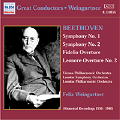 the 1924 Mahler Resurrection led by Oskar Fried, plus gems by Mengelberg, Menuhin, Moiseiwitsch, Powell and Solomon, all in fine new transfers that outshine all previous incarnations. Also: reissues of two essential 1930s Beethoven series – the symphonies conducted by Felix Weingartner and the piano sonatas played by Artur Schnabel. Both artists still impress with tasteful, dignified readings that forego ego and fireworks for intelligence and integrity. the 1924 Mahler Resurrection led by Oskar Fried, plus gems by Mengelberg, Menuhin, Moiseiwitsch, Powell and Solomon, all in fine new transfers that outshine all previous incarnations. Also: reissues of two essential 1930s Beethoven series – the symphonies conducted by Felix Weingartner and the piano sonatas played by Artur Schnabel. Both artists still impress with tasteful, dignified readings that forego ego and fireworks for intelligence and integrity.  Rather than packaging in box sets, individual volumes are being issued every few months. In the case of the Schnabels, the leisurely roll-out is historically significant, as it recalls the manner in which they were first released. Since no commercial label seemed willing to take the risk, this first and in many ways greatest cycle of the Beethoven sonatas was available only in a subscription series – 15 volumes of six or seven 78 rpm discs over the course of seven years. Many stories are told of friends and neighbors excitedly gathered around the phonograph when each precious set arrived. While perhaps nowadays we’re too jaded for that, it’s still wonderful to anticipate each of the eleven scheduled CDs. Previous transfers ranged from bland mush (EMI) to strident sizzle (Pearl), but here Mark Obert-Thorn finds just the right balance between minimal surface noise and maximum musical fidelity. Rather than packaging in box sets, individual volumes are being issued every few months. In the case of the Schnabels, the leisurely roll-out is historically significant, as it recalls the manner in which they were first released. Since no commercial label seemed willing to take the risk, this first and in many ways greatest cycle of the Beethoven sonatas was available only in a subscription series – 15 volumes of six or seven 78 rpm discs over the course of seven years. Many stories are told of friends and neighbors excitedly gathered around the phonograph when each precious set arrived. While perhaps nowadays we’re too jaded for that, it’s still wonderful to anticipate each of the eleven scheduled CDs. Previous transfers ranged from bland mush (EMI) to strident sizzle (Pearl), but here Mark Obert-Thorn finds just the right balance between minimal surface noise and maximum musical fidelity.
Two questions, though - with the classical record industry reeling from dwindling sales, cancelling artist contracts and shying from worthy new projects, shouldn't I feel just a bit guilty touting the recycling of ancient material? No! The industry's economic malaise isn't due to historical reissues, but greedy artist fees, bloated union session costs, daunting retail prices and consumer disillusionment over shoddy and predatory marketing practices.
Second - even though these records are all beyond the 50-year limit of European copyright and thus technically legal, hasn't Naxos deprived producers and artists of royalties they deserve? Again, no! If these were shoddy rip-offs of responsible reissue projects by the creators' heirs I wouldn't support them, but most of this material either has been ignored or the “official” versions were short-lived technical botches. Take the Heifetz concerti - BMG's supposedly authoritative versions in their Heifetz Collection sounded atrocious and have already been deleted after only a few years' availability. BMG has clearly shown us their contempt for these essential milestones of our culture.
Any informed appreciation of music requires understanding its traditions, and for the past century those traditions have been preserved on records. The Naxos commitment to restoring and perpetuating this treasure is one of the most momentous developments of the CD era.
Casals, for one, intended his art as a message of peace to all humanity. Surely he would rejoice to know that his precious legacy will remain readily available.

Copyright 2001 and 2003 by Peter Gutmann
|